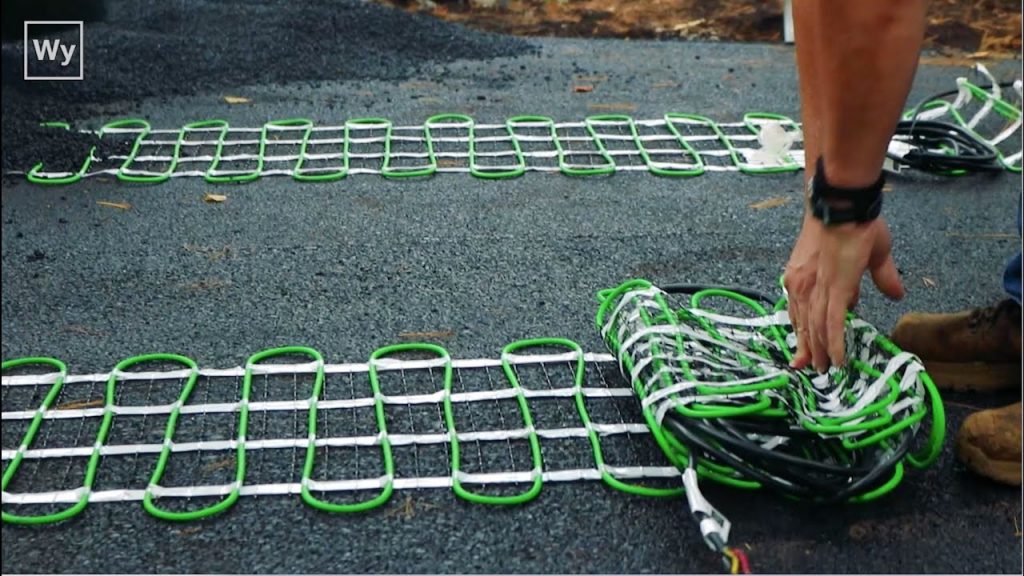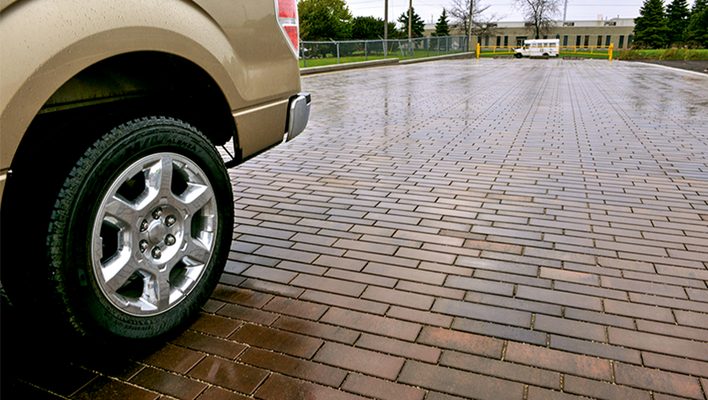DIY Heated Driveway: Types, Installation, Pros, and Cons
Does it snow a lot in your area? You might want a lot of heated gadgets like heated jackets, heated gloves, and heated socks for yourself. What about your vehicle?
A heated driveway is one of the most important items. We will discuss heated driveways, types of heated driveways, best-heated driveways, and DIY heated driveways.
Snow can be very frustrating on a winter day. Having heated driveways can relieve the pain caused by shoveling snow off your driveway.
With a heated driveway, you have the assurance that even in the harshest winter conditions, you can use your vehicle to travel safely.
What is a Heated Driveway?
It is a type of radiant flooring system that heats the floor by using heating tubes. These heating tubes are installed under the floor surface. Usually, hot water is used to heat these tubes. As a result, you don’t need to worry about snow as it melts and keeps your driveway clear.
The heated driveway is also known as snow melting driveway.
Types of heated driveway
There are three types f heated driveways.
- Radiant heated driveway
- Electric heated driveway
- Solar heated driveway
The radiant heated driveway consists of a pump and a hot water boiler. The system heats the water that is circulated through the pipes that are placed under the driveway.
The electric heated driveway consists of an electric supply, a thermostat, and wires that are placed under the floor. Some electric hearted driveway systems use mats instead of wires. As a result, These wires or mats melt the snow and keep your driveway clear.
A solar heated driveway system works on a similar mechanism. However, it gets the power from the sun to heat the water tubes or wires.
Best heated driveway system
The radiant driveway heated system is efficient. However, it requires a lot of maintenance.
Mostly, the electric heated driveway is considered as the best system. It requires minimal maintenance.
The solar driveway heater is the best in the long run as it saves us electricity costs. However, when there are clouds, this heated system becomes ineffective.
If you love to do things by yourself, DIY heated driveway is the best.
How much does a heated driveway cost?
The answer depends upon several factors. It includes the heating system, manufacturer, your existing driveway, and electricity / solar panels cost in your area.
The average cost of the installation of a heated driveway is $4000. However, it depends upon the material, power source, and location.
Usually, the cost depends upon whether you like a concrete driveway or an asphalt driveway.
You can save installation costs by opting for heated driveway DIY.
You can calculate the exact cost by using this heated driveway cost calculator.
The Costs of Different Heated Driveway Systems
If you choose the radiant heated driveway, you should know that a water heater costs a lot. The cost of a water heater for a heated driveway can range from $400 – $100.
A system that uses hot water costs about $6.00, while an electrical heating system typically costs $8.00 per square foot. As they use electricity, they cost a bit more to run.
Installing solar panels would be the most expensive part of solar driveway heating. Solar panel costs about $6 to $10 per watt. An installation of 5kW will be around $21,000 to $38,000.
Heated Driveway Installation
There is a possibility you will not need to add a new driveway if yours is already built. All you have to do is attach the tubes under your driveway and connect them with the main pump and boiler. Furthermore, if you are going to use electricity, you can use wires or mats instead f a pump and boiler.
Some manufacturers also offer a hybrid heated driveway. However, it costs a lot more.
If you are looking to save some money, you can go for a DIY heated driveway system.
Portable heated driveway mats are also available.
If you are an arthritis patient, don’t forget to wear compression gloves.
DIY Heated Driveway
Here is how to make a heated driveway
First of all, makes sure that the weather will be warm enough for at least 30 days. Summer or spring is ideal.
If you want to install a heated driveway yourself, you will need a sledgehammer and a jackhammer.
Break up the existing driveway and level the area. If you don’t have an existing driveway, you can skip this step. Just clear and level the surface.
The driveway’s foundation needs to be covered with a vapor barrier and radiant insulator. The concrete must then be strengthened by laying a grid after the insulation has been installed.
Once the insulation is done, lay down the heating tubes. You need to make sure that heating tubes are at least 1.5 inches apart. Furthermore, you can use a tape that is specifically made for this purpose.
Now, connect the heating system with the boiler and main system. In the case of the electric system, spread the wires/mats and connect them with the main eclectic supply. Also, if you are using solar panels to heat your home, connect the wires to the solar panels.
Finally, place the top layer of the driveway over the whole system.
There are so many heated driveway kits on the market. So, the installation process can differ depending on the manufacturer. Make sure to read the instructions before going for a DIY heated driveway system.

Heated driveway pros and cons
The pros of a DIY heated driveway include less effort to get rid of snow, less environmental damage, and low maintenance costs.
The cons of a heated driveway include installation costs, heating costs, and repair costs.
Can you heat an existing driveway?
Yes, you can heat an existing driveway. However, it depends on how your existing driveway was built. Which material was used? Will you be able to install a heated system without breaking it? Finally, how has your heated driveway kit been designed to work?
When is the best time to install a heated driveway?
Summer or spring is the best time to install a heated driveway. Ideally, when you know that the next 30 days’ weather will be clear is the best time.
How much snow can a heated driveway melt?
A heated system can melt at least two inches of snow an hour, and the melting snow will not refreeze while it is being used.
How long does a heated driveway last?
A DIY heated driveway can easily last 10-20 years. However, if there is any mechanical damage, it won’t last long.
Heated Driveway Alternative
The best alternative to a heated driveway is snow-melting mats. They are designed to withstand the weight of individuals as well as vehicles.
For a snow-free tire lane, the mats are laid out straight. Their use is cost-effective as they run on ordinary outlets.
Also read: Raynaud Disease Gloves :Are they effective?
Did you know that towel warmers can keep your towels hot and clean?
Additional Questions
What are the different types of driveway heating systems?
Driveway heating systems broadly fall under three categories: **hydronic (water-based), electric, and portable heated mats**. The design and operation of these systems vary greatly, with each offering its own unique benefits. The hydronic and electric systems are embedded beneath the driveway surface and operate seamlessly and often require little to no maintenance after being installed professionally. On the other hand, portable heated mats are a flexible, less permanent alternative that can be conveniently laid down when needed. Proper drainage is critical to the effectiveness of the system and a seasoned paving expert can ensure this is accomplished correctly. Learn more.
Are heated driveways worth the money?
Concerning the monetary value, the worth of a heated driveway seems relatively subjective. It essentially boils down to your individual set of circumstances. For those who live in colder regions where heavy snowfall is a common occurrence or have an unusually long or steep driveway, **investing in a heated driveway could certainly be worthwhile**. Offering an impressive performance, a properly functioning heated driveway can melt as much as two inches of snow hourly. This not only means you have clear and safe access to your home all winter long, but you can also save time and effort otherwise spent on shoveling snow and de-icing.
Do heated driveways go bad?
In terms of longevity and durability, I find that electric heated driveway systems perform exceptionally well. Using a grid of heating cables and mats to produce heat, these systems are designed for longevity. Generally, they **can last for several decades** with only minimal maintenance needed. From my experience, they are also simpler to install than their hydronic counterparts. You won’t need a boiler – a factor that significantly simplifies the installation process. Additionally, I have found, as have others, that electric systems are typically more energy-efficient than hydronic systems, which can equate to lower utility bills down the road.
What are the two most common systems used in heated driveways?
Driveway heating systems primarily come in two popular varieties known as **electric and hydronic**. Each of these systems relies on a network of heating elements embedded beneath the driveway surface to provide heat. The heating elements can be either special PEX tubing (Typicallyused in hydronic systems) or electric heat resistance cables (Often employed in electric systems). Both these types satisfactorily melts snow and ice, helping homeowners maintain a clear and safe driveway even in severe winter conditions.

I’ve been in the printing business for 25 years. I love to share my experiences and knowledge.


